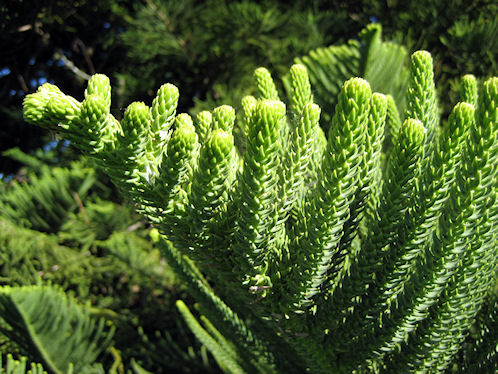Non - Xeriscape.
Common Landscape Plants. Shrubs, Flowers, & Trees.
For The Arizona Desert Environment
Pictures, Photos, Images,
Descriptions, & Reviews.
Norfolk Island Pine, Araucaria heterophylla.
Indoor Plant.
We Are Proud Of Our SafeSurf Rating!
Click On Any Of The Following Links By Amazon.Com
For Books, & Videos About Wildflowers Of Arizona & The Southwest USA. No Obligation!
| Norfolk Island Pine, Araucaria heterophylla. Tree. Photo Courtesy: Wikipedia, the free encyclopedia. Norfolk Island. |
|---|
| Norfolk Island Pine, Araucaria heterophylla. Tree. Inside, House Plant. Glendale, Arizona. Make Sure It Has Plenty Of Sunlight! |
 |  |
| Norfolk Island Pine, Araucaria heterophylla. Tree. Leaves. Photo Courtesy: Wikipedia, the free encyclopedia. | Norfolk Island Pine, Araucaria heterophylla. Tree. Cones. Photo Courtesy: Wikipedia, the free encyclopedia. |
|---|
 /
/

Norfolk Island Pine We wish to thank Wikipedia, the free encyclopedia for some of the information on this page. We share images and information with Wikipedia. Norfolk Island Pine or Star Pine, has become the perfect living Christmas tree for people who wish a living Christmas tree in just about every part of the UnitedStates. From outward appearances there is little to indicate that the small tabletop specimens, that we find in most home improvement stores, adorned with red bows and miniature ornaments, are in reality a forest giant that can reach 200 feet in height, from the South Pacific. We were tempted and bought a potted Norfolk Island Pine as a live Christmas tree in 2011. We have since, kept the tree as a houseplant. It is doing very well. We learned that it won't survive outside in the hot arid climate of the Phoenix Area, or in the colder areas of Arizona either. Therefore, we have kept two of them alive as a houseplant in a sunny location of our two homes. Norfolk Island Pine or Star Pine is native of; Norfolk Island, a small island in the Pacific Ocean between Australia, New Zealand and New Caledonia. The genus Araucaria occurs across the South Pacific, especially concentrated in New Caledonia. Norfolk Island is in the middle of the South Pacific, about 900 miles due east of the eastern bulge of Australia. The tiny island consists of only 13 square miles. In its splendid isolation from outside influences, the Norfolk Island pines evolved into a unique race of plants unlike the other dozen Araucarias scattered across the South Pacific. Norfolk Island was discovered in 1774 during the second voyage of exploration by Captain James Cook on behalf of the Royal Navy. On this voyage as captain of the Resolution, Cook was at sea for just over three years and logged more than 70,000 miles. At one time the crew went 117 days without seeing land. Captain Cook, who discovered New Zealand on his first voyage and Antarctica on his second, was killed on his third voyage by natives of the big island of Hawaii in 1779. As a landscape tree, it grows ramrod straight with whorled branches arising at right angles to the main trunk. These swoop down in a graceful sweep creating a picturesque form for older trees. The flattened, incurved, awl-shaped needles are light green, quarter-inch long affairs that sheath the young branches. The commercial trees that we buy in the stores at Christmas are all grown from seed, therefore, we see only the juvenile foliage. As the needles reach a few years' age, they begin to fall off, leaving bare, inner branches. In Arizona, after a few years as a houseplant, the tree will get too tall for your home. At that point, there is not too much you can do with it. It won't survive our hot climate!
Quick Notes:
Height: 140 - 200 feet tall. 20 -30 feet spread.
Bark: Grayish-brown, exfoliating in fine scales.
Trunk: Up to 5 foot, 8 inches in diameter.
Flowers: Male cone in clusters, elongated, 4 cm. long, yellowish-brown or reddish; microsporophylls acute, margins ciliate, denticulate. Female cone broader than long, 12-15 cm. long, with triangular scales and a long incurved bract..
Blooming Time: Non-flowering .
Leaves: The foliage is soft looking and light green. Leaves on young trees are narrowly wedge-shaped, about 0.5 in (1.3 cm) long; on mature trees the leaves are scalelike and overlapping, about o.25 in (0.6 cm) long.
Seeds: Brown oval - wing - shaped seeds about 1/4 inch in length.
Found: Norfolk Island, a small island in the Pacific Ocean between Australia, New Zealand and New Caledonia. The genus Araucaria occurs across the South Pacific, especially concentrated in New Caledonia.
Elevation: 0 - 2,500 Feet.
Hardiness:
Soil pH requirements:
Habitat: South Pacific.
Miscellaneous: Plant has spines or sharp edges; use extreme caution when handling. Pollen may cause allergic reaction.
|
We Are Proud Of Our SafeSurf Rating!



We Are Proud Of Our SafeSurf Rating!
Click On Any Of The Following Links By Amazon.Com
For Books, & Videos About Xerioscape Plants Of Arizona & The Southwest USA. No Obligation!
| © 1966 - Present, Audrey, Eve, & George DeLange |


